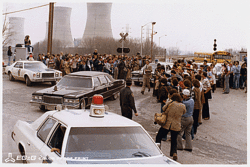Top 10 Stories of 2009 #3: What really happened at Three Mile Island?
Today we continue our series on the Top 10 Stories of 2009 here at Facing South. You can see numbers 6 to 10 here, here, here, here and here. And coming in at #3 ...
 In recent years, business and government leaders -- especially in the South -- have been pushing nuclear power as the solution to our energy woes, including climate change.
In recent years, business and government leaders -- especially in the South -- have been pushing nuclear power as the solution to our energy woes, including climate change.
If only they'd remember what happened 30 years ago at Three Mile Island. Facing South reporter Sue Sturgis found two people who remember the nation's largest nuclear disaster very well: Randall and Joy Thompson, two nuclear health physicists-turned-professional clowns who were there after the catastrophe at the Pennsylvania power plant.
Sturgis' in-depth tour de force -- published exactly three decades to the week since Randall Thompson set foot on the TMI disaster site on April Fools Day 1979 -- was the first to tell the Thompsons' story, which is at odds with the official version of what happened that fateful day.
She also revealed the lingering questions about the TMI disaster that should send a big "hello" to those who think nuclear is a safe path for our energy future.
As Sturgis writes, it wasn't the first time they had attempted to share their experiences -- but their efforts to reveal what they knew turned into a veritable "John Grisham thriller":
They tell of how a stranger approached Randall Thompson in a grocery store parking lot in late April 1979 and warned him his life was at risk, leading the family to flee Pennsylvania. How they ended up in New Mexico working on a book about their experiences with the help of Joy's brother Charles Busey, another nuclear Navy vet and a former worker at the Hatch nuclear power plant in Georgia. How one evening while driving home from the store Busey and Randall Thompson were run off the road, injuring Thompson and killing Busey. How a copy of the book manuscript they were working on was missing from the car's trunk after the accident. These allegations were detailed in several newspaper accounts back in 1981.
With help from the Thompsons and other nuclear experts, Sturgis revealed how the official story about the mount of radiation released into the environment didn't add up, and how the government has downplayed evidence of lingering health threats to nearby residents.
She also reported that, contrary to the claims of the nuclear industry, many of the problems that led to the TMI disaster could happen in the "new generation" of nuke plants being proposed for the South (and definitely could happen at the aging facilities in use now).
Only fools would ignore these serious questions.
Want to help Facing South keep breaking the big stories? Make a special, year-end tax-deductible gift to the Institute Investigative Fund -- and our new special project to train Southern bloggers, the Freedom Journalism School -- today! If you donate by December 31, 2009, a Facing South reader will match all gifts up to $10,000. Go pitch in now!
Tags
Chris Kromm
Chris Kromm is executive director of the Institute for Southern Studies and publisher of the Institute's online magazine, Facing South.
